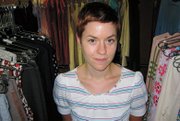Hard Bargain
Local designer outlets carefully avoid conflict with first-run retailers
Location is everything in retail. Sometimes that means being as isolated as possible.
The Circle is a small clandestine studio in a corner of Los Angeles’ Silverlake district. It’s loaded with buried treasure—and about as easy to find.
Founded a year and a half ago by veteran fashion industry publicist Brian Watson, the store is an outlet for local designers, with items selling at 40 percent to 80 percent discounts. Lines include Mon Petit Oiseau, Burning Torch, Alicia Lawhon, Ash Francomb, Grey Ant and many others.
But because the same designers sell their clothes for full price at many Los Angeles boutiques, The Circle treads a tricky path; it needs to promote itself to stay in business, but it does not want to impinge on the competing retailers that form its designers’ primary accounts.
Hence, the low-profile location, far from the doors of other retailers.
Calvin Klein unloading truckloads of jeans on a discounter like Ross Stores is one thing. But when local designers need to get rid of excess backstock, the potential for conflicts of interest arises.
For the most part, designers are prudent not to step on the toes of their primary retail accounts. “As a manufacturer, my first loyalty is to the retailer,” said Darren Gold, president of the Coalition of Los Angeles Designers and co-designer of the Los Angeles label Mhope.
But other times, especially with sample sales, the need to offload excess inventory wins over many of his peers.
“It’s tricky because you can make a lot of money at sample sales,” Gold said. “But you can’t just throw out old stuff that you’ve had for two years. The customer doesn’t want that. The public has become very savvy about sample sales. They want current stuff, and they know they can get it at the sales.”
Billion Dollar Babes, a popular quarterly sample sale, now requests that all vendors provide current merchandise, according to Gold, who said some local brands sell at sample sales the same merchandise currently available in department stores. Savvy shoppers have caught on and are increasingly viewing sample sales as a way to get the latest styles at substantial discounts.
“It’s rough because if [your line is] half a mile away in a store, you can’t really put things in a sample sale for wholesale prices,” Gold said.
Some retailers have admonished designers not to sell current merchandise at sample sales, Gold said. Still, some willfully go behind retailers’ backs in an effort to unload merchandise and generate cash flow. “It’s easy to say, ’The store probably won’t find out,’” he said.
Gold and co-designer Marla Folbe avoid the potential conflict by making special fabrications of Mhope items for the Billion Dollar Babes show, which Gold said he values for the exposure it brings to his label.
At The Circle, manager Leslie Kharma said she clearly outlines the rules to the designers she carries. “We specify to designers that we will only carry backstock so we will not potentially create a problem with their primary retailers,” she said.
So far the only problem the store experienced was when it first opened. The store distributed fliers throughout the city with a list of the featured designers, and some retailers called to complain.
But Kharma said many retailers visit the outlet and feel it ultimately helps them by bringing greater recognition to designers.
Still, without a proper storefront and with sales that “have not been wonderful,” The Circle is considering moving. The challenge, Kharma said, would be to find a new location that would offer improved traffic but that would not conflict with other retailers.
Samira Arkel’s Last Chance is located across the street from the historic Helms Bakery building in Culver City, Calif. Last Chance is also an outlet for local designers, and, according to Arkel, the unassuming location is necessary. She admits that being an outlet for local lines puts her—and the young up-and-coming designers she carries—in a touchy situation.
Last Chance’s inventory includes Tree, Joie Jeans, Beautiful People and Ya Ya. The store is a popular destination for wardrobe stylists in the entertainment industry.
With three years in business and some $500,000 in annual sales, Arkel said she is torn between wanting to promote the store and wanting to remain somewhat secretive for fear of angering her designers’ other retailers.
The tricky situation has stung her once before. One of the designers she carries had to pull his clothing from her store after a retailer complained. She stressed that the designer has since rejoined the racks of Last Chance.
Tracy Wilkinson of Mon Petit Oiseau also sells her backstock to Last Chance. She has ensured a win-win-win situation for her, her retailers and her outlets.
“I don’t sell anything [in the outlet stores] that isn’t a year old,” Wilkinson said. She sets the same policy for sample sales.
“I think all designers are aware that they really have to look after their number-one customers,” she added.






















